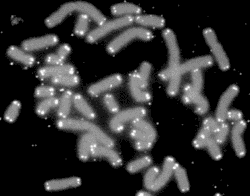Telomere
From CreationWiki, the encyclopedia of creation science
Jump to navigationJump to search
A telomere (Greek: τέλος, telos, meaning "end" and Greek: μέρος, meros from the root μερ meaning "part") is a region of the end of a chromosome composed of an unusual strecth of repeated sequences that together with certain specialized proteins, forms a cap.[1] The telomere has two important functions. The first is to protecting the end of the chromosome from deterioration or from fusion with neighboring chromosomes. The second is that telomeres act as a specialized origin of replication allowing the cell to replicate the ends of the chromossomes.[2]
External links
References
- ↑ Karp, Gerald (2008). Cell and Molecular Biology:Concepts and experiments (5th ed.). Hoboken, NJ: John Wiley & Sons. p. 503. ISBN 978-0-470-04217-5.
- ↑ Watson, Jamed D.; Baker, Tania A.; Bell, Stephen P.; Gann, Alexandrer; Levine, Michael. Losick, Richard (2004). Molecular Biology of the Gene (5th ed.). San Francisco, CA: Pearson, Benjamin Cummings/CSHL Press. p. 139-140. ISBN 0-8053-4642-2.

